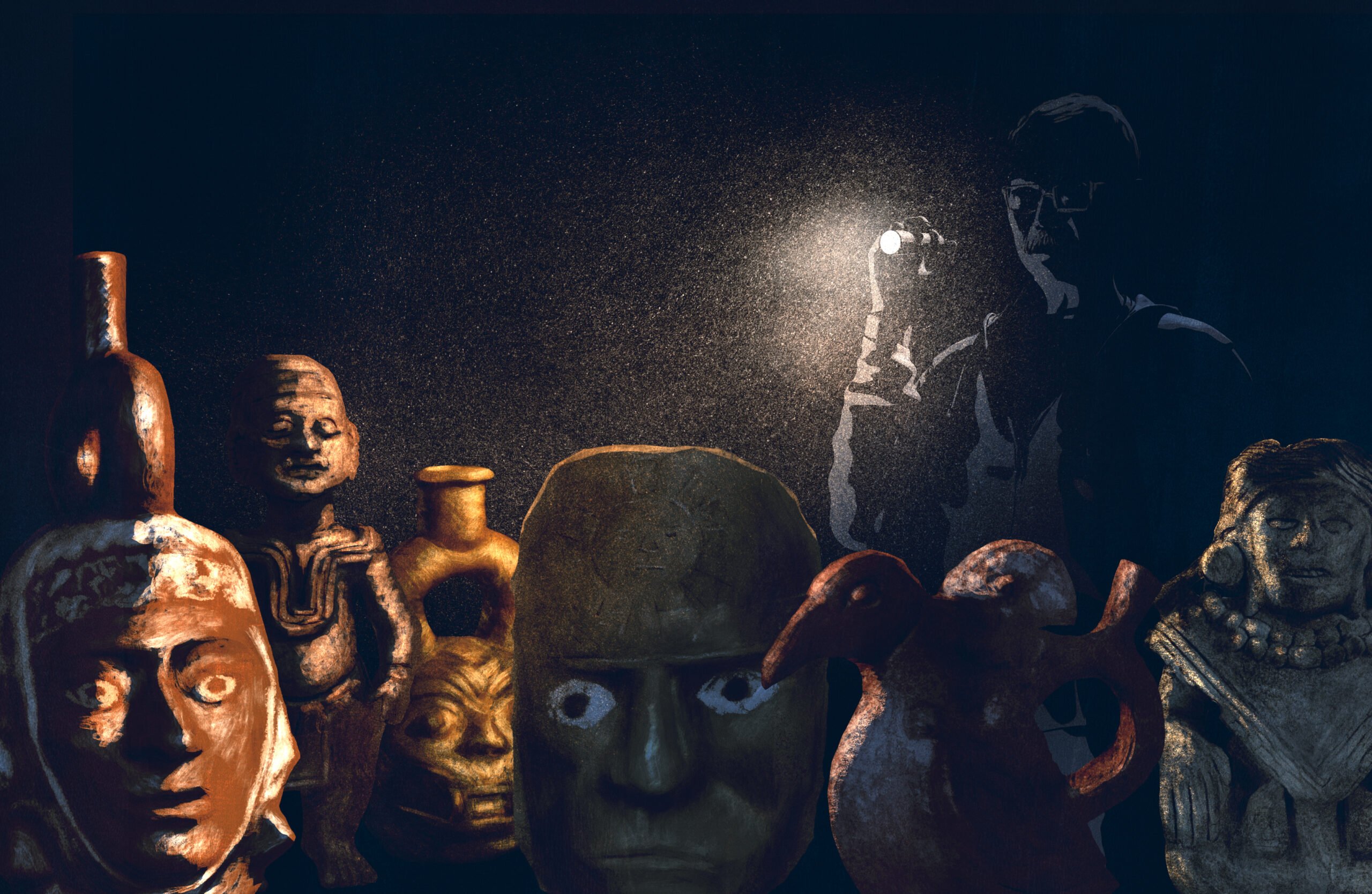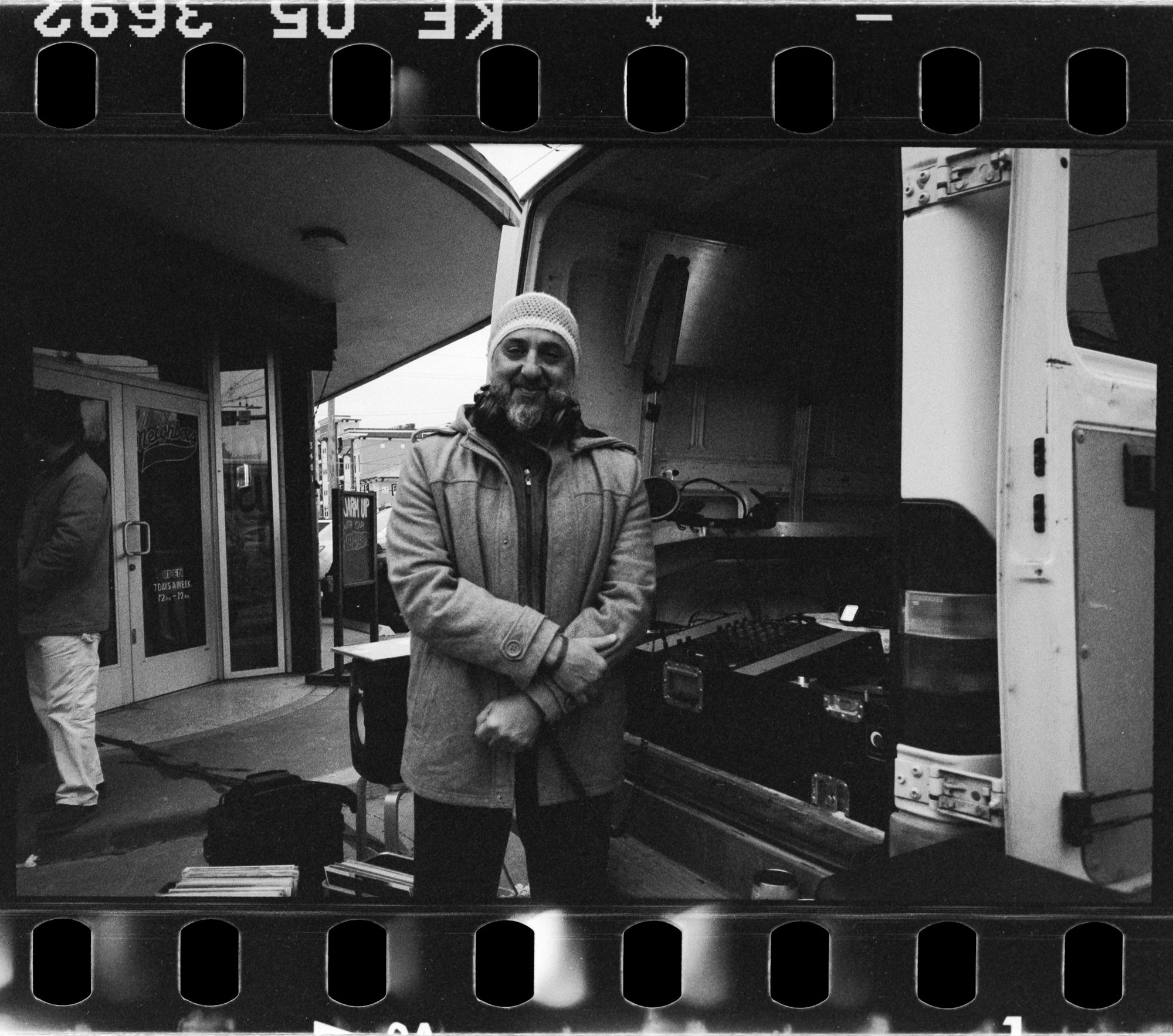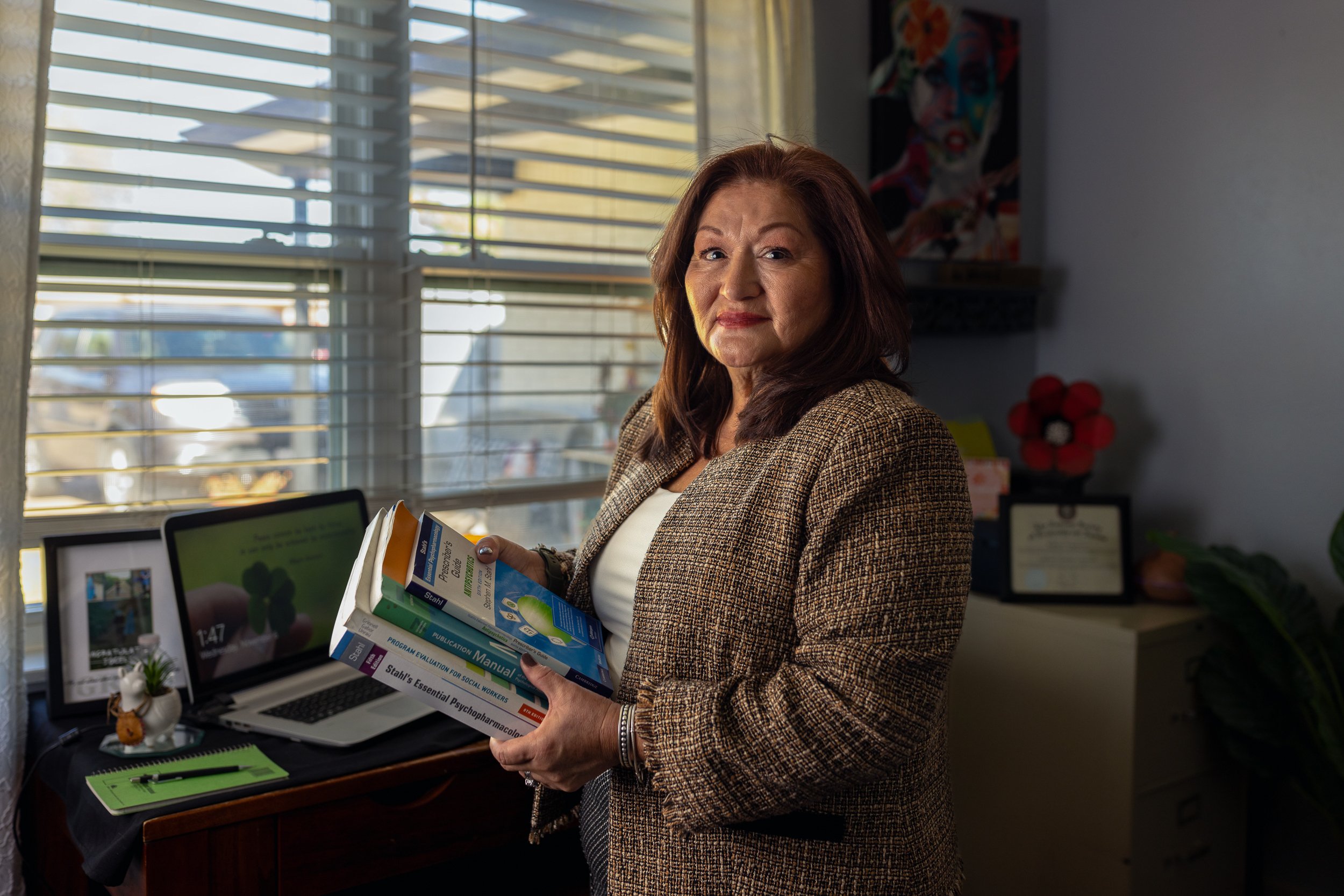On February 23, 2001, professor Thomas Guderjan accompanied other Texas Christian University (TCU) researchers and a librarian to the locked door of storage room L10C in the basement of the Mary Couts Burnett Library. The group intended to locate pre-Columbian Peruvian textiles donated to the university between 1995 and 1997, along with pottery and ritual artifacts, in order to move some items to the university’s design department. As an anthropology professor, Guderjan felt excited: He’d heard of the collection’s existence when he joined the faculty the year before, but had never seen it.
But when they entered the room, Guderjan and the others found only a series of plain cardboard boxes of various sizes stacked on wooden pallets. As the group proceeded to search for textiles, they realized they had stumbled onto a crime scene.
Box after box revealed only bubble wrap, while others held only bits of broken pottery. Very few cartons still contained intact objects. The group shared their discovery with Head Librarian Bob Seal, who contacted the TCU Police Department. Detective Kelly Ham, dispatched to investigate the theft, noticed more shards of broken pottery in a hallway close to an external exit. Further investigation later revealed that the thief had, over weeks or months, absconded with the antiquities a few at a time, restacking the empty boxes upside down to show the unbroken tape on the undersides.
Presuming the suspect might return, police and university officials returned the boxes to their original locations, initiated video surveillance, and attempted to prevent the story from leaking.
But after staking out the storage room for a little over a month, police recommended that the university break its silence. In an interview, Guderjan, who now works at the University of Texas at Tyler, recalled that TCU authorities hoped spreading the news might lead potential buyers or associates of the culprit to call in tips for law enforcement. On March 26, TCU’s student newspaper the Daily Skiff broke the news, and two days later the Fort Worth Star-Telegram followed up.
Within days, those stories yielded results.
The thief “extracted three large leaf trash bags full of the pottery.”
On March 29, a private investigator named Janie Brownlee contacted Detective Ham, stating that a confidential informant knew someone who had somehow acquired some of the stolen antiquities. Later that evening, Brownlee asked to meet with Ham at midnight near the intersection of Loop 820 and Granbury Road in Fort Worth, where Brownlee handed over “five black trash bags containing seventy of the stolen artifacts. Eleven … were broken or damaged,” the detective noted in his report.
Houston Police Department officials contacted Ham to say that a 50-year-old man named Ralph Prude had turned over 10 more artifacts. Ham drove more than 250 miles to Houston on March 31 to retrieve the objects and meet with Prude, who named a potential suspect: David Earl Word, a former employee of TCU. Prude also promised to pass along Ham’s number to Word.
On April 1, Ham arranged to meet Word at King Cole Liquor on Richmond Avenue in Houston, where he had relocated after the thefts. During their encounter, Word told Ham that he had entered the TCU library to warm up on a cold night and wandered into the basement where he found boxes labeled “pottery.” Intoxicated, he decided to stuff two or three pieces in his backpack. He continued the pattern over the next few days. One night around 3 a.m., Word and an unnamed acquaintance drove to the university in a van. Word entered the TCU building and extracted “three large leaf trash bags full of the pottery,” according to the TCU police report.
At the end of the meeting, Ham did not arrest Word, who promised to surrender the following day. But Word never showed. Finally, on April 4, Word contacted Ham and again agreed to surrender, and Ham brought him back to Fort Worth.
TCU police later determined that Word stole 105 antiquities valued at $266,200. Most were recovered, though more than a dozen pieces were damaged. But Word never did any prison time. He pled guilty to second-degree felony theft and was given 10 years’ probation and ordered to pay TCU $17,800.
TCU used those payments to pay its insurance deductible. More than 20 years later, the university still displays some of the same antiquities police recovered, though the thefts drew attention to its lack of security.
The incident also raised lingering questions about the university’s original acquisition of the antiquities—and about whether Texas universities and museums in general do enough to vet such donations.
When Donald F. Moorehead, Jr. gave the collection of Peruvian antiquities to TCU in the 1990s, he provided no information about how they came into his possession, according to university records. Moorehead was a corporate waste management mogul, not an art collector or antiquities dealer. Moorehead did provide appraisal reports detailing the approximate era and cultural origin of each item, according to a deed of gift retained by TCU officials. According to that document, peoples from the ancient Andean cultures of modern-day Peru—including the Chavín, Nazca, Mochica, Chimú, Paracas, and Recuay—created the objects.
The collection contained painted pottery and textiles intended for everyday use or ceremonial purposes. It also included anthropomorphic figures, erotic pottery, and portrait stirrup vessels used for chicha, an alcoholic beverage made from fermented purple maize and consumed during religious rituals to pay tribute to the dead.
Archeologists have identified many objects similar to those donated by the Mooreheads, often buried in large quantities in the graves of royals and other elites to assist them in their afterlife. Such grave goods have long been targeted both by art dealers and thieves.

Modern-day Peru, home to some of the Americas’ wealthiest pre-Columbian cultures, has a well-documented trail of thefts of its cultural patrimony. The country’s most infamous looting occurred in an active archaeological site centered around the royal tombs of Sipán in Limbayeque. The archaeological community considered Sipán to house “the richest ancient tombs in the New World” when excavations began in the late 1980s, as Peruvian archeologist Walter Alva wrote. He and others found that the wealth of grave goods, such as golden masks and ornate headdresses, interested academics and thieves alike, with the latter raiding the tombs as early as 1987. Stolen objects from Sipán spread on the global black market, finding their way into public and private collections primarily in the United States and Europe.
In 1929, Peru passed a law declaring national ownership of its cultural patrimony and prohibiting the removal of any discovered antiquities. Yet Peru’s law proved ineffectual to prevent ongoing thefts, antiquities trafficking experts say, partly because countries like the United States with active antiquities markets refused to prevent the importation or trade of the items.
The United States has entered into a total of 20 bilateral agreements to protect foreign antiquities since the 1990s. But it balked at adopting a more restrictive proposal crafted by an intergovernmental organization called the International Institute for the Unification of Private Law in 1995 that called for a crackdown on collectors that use dubious acquisition practices.
Many U.S. museums and universities collect antiquities because the ability to catalog and display valuable artifacts elevates their status, reputation, and research capabilities. Prestigious institutions like the Smithsonian and Harvard University regularly invite anthropologists and historians worldwide to study and write about their collections.

But according to archaeologist Donna Yates, an expert on the illicit trade, “Most of the antiquities that have been acquired by collectors and museums in the past and that are on the market now are at least illicit in some way, and many are held illegally.” As Yates wrote in the Journal of Financial Crime, in one of several articles on antiquities trafficking, many museums and universities are reluctant to return or refuse donations of questionable provenance “because of desire to compete with other museums or because of a sincere belief that a museum is the best place for the object.”
At times, the value of donated art or antiquities collections might be inflated by fraudsters in order to overstate the value of a charitable gift as a tax write-off. The appraisal process of art and antiquities is highly subjective, and the opinions of ostensible experts are difficult to challenge, Yates said, creating the potential for abuse.
Antiquities-related tax deduction schemes first garnered attention in the 1970s and 1980s when undercover IRS agents exposed criminal networks connected to prominent institutions such as the Getty, the Smithsonian, and the Los Angeles County Museum of Art. Museum officials colluded with art dealers by accepting donations of foreign antiquities that lacked detailed provenance and had been highly inflated. The donors typically “never saw, much less owned, the objects they gave, but lent their names to the transactions in return for generous tax write-offs,” one participant told the Los Angeles Times in 2008.
The Los Angeles Times investigation found that art donors “reap nearly $1 billion in tax write-offs” every year. Few are audited, but “half of the donations checked over the last 20 years had been appraised at nearly double their actual value.”
Such cases have prompted proposals to tighten federal regulation of the appraisal industry and to reduce the limits of deductions. But given that the vast majority of acquisitions are donated, museum officials have warned that lowering the incentive to donate could have serious consequences for the future of public art.
In 1998, Donald Moorehead, the TCU antiquities donor, was inducted into the Environmental Industry Hall of Fame for “outstanding contributions to the waste industry.” Later that same year, Moorehead played a major role in creating the one of the world’s largest trash-hauling businesses. He was “a legend” in the garbage business, according to a eulogy delivered by his niece when he died in Allen in 2022.
During the TCU theft investigation, an expert opined that the value of the items he’d donated to TCU as the Moorehead collection had been inflated in 1996, according to TCU police reports and related documents.
TCU records show that Sue Bergh, then-associate curator at the Cleveland Museum of Art, wrote to TCU’s associate vice chancellor, Larry Adams, via email on March 29, 2001, saying that she believed he should seek another expert opinion and that the initial appraisal of nearly $400,000 for the Moorehead collection was likely high. “If my memory of the value of the ceramics serves, they were overvalued at the time of the gift,” she wrote. (Bergh, retired, could not be reached for further comment.)
According to Guderjan, Moorehead had previously attempted to donate the collection to other institutions before approaching TCU. Guderjan said he suspects the collection was rejected by others because it lacked clear provenance and because, in his opinion, the value was “highly inflated and incorrect.”
Kenneth Linsner, an independent appraiser used to assess the value of the Moorehead collection during the time of the TCU donations, according to a TCU police report, declined to address questions Berge raised in her letter. In an email response to the Texas Observer, Linsner said he had “no recollection or comment” about the specifics. He emphasized that he follows The Uniform Standards of Professional Appraisal Practice, which require the “keeping of records” for “a few scant years and not decades.” (Linsner also said via email that he worked “under contract” with the federal Internal Revenue Service [IRS] from 1983 to 2000.)
The IRS never publicly accused the Mooreheads of overreporting the value of their gifts to TCU, according to the university and court records reviewed for this story. Those donations were made in the names of Donald Moorehead and of his ex-wife Shelley Moorehead. Moorehead died in 2022; Shelley Moorehead did not respond to questions about the donation that were emailed to the Mooreheads’ eldest son.
At the time of their donation to TCU, Donald and Shelley Moorehead lived in Houston’s River Oaks. But, according to TCU records, the objects were shipped from a warehouse in New York City owned by a company called Abbey Art Consultants, Inc. When the shipments arrived at TCU in 1996 and 1997, Nancy Wilson, director of gift planning, expressed concern in a memorandum that the artifacts were “not well packed” and that some objects were either missing or damaged. (Wilson died in 2019.)
In the 1990s, Abbey Art Consultants participated in helping individuals sell or donate antiquities, sometimes reaping tax benefits for their clients. In a deal brokered in 1996, Abbey Art sold lawyer and Mobil Oil employee Joseph B. Williams III a large collection of foreign antiquities. In a contract Williams signed in 1996, Abbey Art guaranteed that the “purchase price shall not exceed 24% of the cumulative appraised fair market value of the art,” court records show. Williams later donated the items to Drexel University in exchange for tax deductions, according to federal court records. Abbey selected the appraisers, recommended the donees, handled the paperwork, packaging, and shipping, and even “agreed to share the risk of inflated appraised values by promising a pro-rata refund of the discounted purchase price.”
The donor was a “legend” in the garbage business.
In the 1997 deal, Abbey Art used three appraisers to evaluate different portions of the collection of articles Williams donated to Drexel University, according to court records.
Kenneth Linsner, the appraiser hired to assess the Mooreheads’ donation, according to TCU records, was also one of the three used to appraise part of Williams’ 1997 donation to Drexel, according to court records. (He was not involved in appraising two other antiquities collections Williams later acquired from Abbey and donated, according to tax court records.) Linsner did not respond to specific questions related to his involvement with Abbey Art. In an email response, he said he “was not an employee of Abbey Art, nor a member of the firm, nor under contract to the firm nor anything but an independent appraiser.”
Available records do not show whether the IRS ever questioned the Mooreheads or Abbey Art about the TCU donation. Federal court records show that more than a decade after donating the Peruvian objects to TCU, the Mooreheads were audited by the IRS. But the audit makes no mention of the antiquities donation, according to a lawsuit the Mooreheads filed to challenge it.
But Williams, Abbey Art’s other client, was audited by the IRS and his dealings with Abbey Art came under scrutiny. In 2007, the IRS issued Williams a notice of deficiency for the tax years 1993 through 2000 involving unreported overseas income and charitable donations of appreciated art, according to civil and tax court documents. The IRS determined that Williams violated tax law by donating art at values far above his purchase price before officially owning it for the required holding period of one year. The agency did not challenge the valuations, but the U.S. Tax Court opined that both the “deeply discounted” prices Abbey’s offered its customers based on bulk purchases of art “in third-world countries” and the appraisals of the objects were “suspect.”
The IRS limited Williams’ charitable deductions to the amounts he paid for the art and charged him penalties for excessive deductions, records show. In 2003, he pleaded guilty to tax evasion and conspiracy to defraud the IRS in the U.S. District Court for the Southern District of New York and was sentenced to 46 months, according to court records. He was released in 2006. (Williams’ attorney declined comment via email; Abbey Art Consultants is no longer in operation.)
In the 1990s, TCU was ill-prepared to properly care for and handle the Mooreheads’ large donation of objects. Left in boxes inside a locked but otherwise unsecured basement, the antiquities were vulnerable to damage and theft.
Thefts from a museum or university collection create an embarrassing situation that can harm an institution’s reputation as a repository of antiquities. Records show that TCU police and administrators carefully curated the narrative released to the Daily Skiff after the theft of the Moorehead collection. On March 28, 2001, Tracy Syler-Doctson, the assistant director of communications, circulated an internal memo providing Guderjan and university librarian Robert Seal talking points to use “when dealing with the media.” Syler-Doctson advised them “not to go into specifics about the security system” but to assure reporters that the university was “reviewing security measures.” The memo mentioned that an inventory taken in February 2000 had verified that all items were secure and that “only authorized individuals had access to the secured archival area.”
But Ham, the TCU police investigator, discovered that over 400 individuals had access to the room that housed the objects, including student workers, faculty, maintenance staff, and instructional services personnel. Dozens of people had unauthorized access to the storage room for at least several months, possibly over a year.
The thief promised to provide “all sorts of juicy information concerning the utter lack of security at TCU.”
The list included Word, the thief, who confessed to Ham that even as a low-level painting contractor he easily copied his key, giving himself long-term access. While incarcerated in the Tarrant County Jail, Word wrote to Ham claiming he planned to give the Fort Worth Star-Telegram “all sorts of juicy information concerning the utter lack of security at TCU.” But there’s no indication that Word gave any such interviews.
Since the 2001 heist, TCU officials say they have taken significant measures to improve security. Once authorities recovered the stolen items, the university placed Miguel Leatham, an anthropologist with an interest in folklore and religious movements, in charge of its care. Leatham ensured that the textiles in the collection received proper preservation in a more secure environment. Only two unnamed TCU officials hold keys to display cases containing pottery, and those cases are monitored by security cameras.
Far from Fort Worth, world-renowned institutions such as the Bibliothèque Nationale de France in Paris have also suffered at the hands of thieves. In 1982, a Mexican lawyer named José Luis Castañeda del Valle posed as a student researching a well-known Nahuatl divinatory manuscript known as the Aubin Tonalamatl in the library. Once granted access, del Valle slipped the codex into his jacket, extracted it from the library, and fled to Mexico. Though Interpol apprehended him, the culprit gained notoriety, claiming he only took the manuscript to return it to its proper home. Mexican and French authorities later negotiated a permanent loan for the record to remain in Mexico’s National Institute of Anthropology and History.
Leaders of the art world in the Global North have long used the lack of security in the Global South as an argument against repatriating antiquities. But antiquities thefts persist in the Global North too. In the summer of 2023, the British Museum fired an employee for stealing jewels from a storeroom that lacked proper security. The thief, like Word, may have been stealing from the museum for an extended period without detection.
Some have argued that cooperation with museums in Latin America poses serious challenges, but any astute visitor to the Lives of the Gods: Divinity in Maya Art exhibit in Fort Worth’s Kimbell Museum of Art last year would have noted that 40 percent of the antiquities on display were loaned by Mexican and Guatemalan institutions. The thefts in Paris, London, and at TCU demonstrate that the Global North can claim no moral high ground regarding antiquities thefts: Objects are vulnerable abroad as they are in their countries of origin.
TCU officials initially viewed the Moorehead donations as an opportunity to enhance the university’s prestige while building a collection that could encourage the study of Latin American cultures. An exhibit brochure from 1997 reveals the donation was met with excitement but little understanding of the material. A brochure described techniques for making Peruvian pottery without providing any cultural context for the artifacts or their use. Only after the theft, when the collection was placed under the care of the Sociology and Anthropology Department, did a clearer picture of the objects begin to emerge.

In the decades following the donation of the Moorehead collection, TCU anthropologists and other researchers have worked to identify the objects’ origin with greater precision. In some cases, they have confirmed the object’s specific culture of origin and narrowed the timeframe to ranges of two or three centuries. However, the objects’ provenance—the specific places of origin and discovery—remains lost to history.
Modern archaeologists routinely record an object’s exact location in any specific excavation site, building, or even room. The lack of such information associated with the Moorehead collection adds another layer of mystery to a troubling history of collecting and displaying pre-Columbian antiquities in the Global North.
Prior to the 20th century, the United States and other imperial powers in Western Europe such as Great Britain and France collected, studied, and displayed antiquities as trophies of their empires. Entrepreneurs and representatives of these nations’ institutions legally collected but also made illicit purchases and in many cases turned to theft. Many early collectors also did not prioritize recording details of their acquisitions, leaving many objects taken from Latin America during the 19th century without identifying information beyond the country of origin.
More recently, David Hidalgo, co-founder of OjoPúblico, a Lima-based online magazine of investigative journalism, helped compile a searchable database documenting details of stolen cultural property from Peru and other countries in Latin America as part of a years-long project called Memoria Robada, “Stolen Memory.” The OjoPúblico investigation has helped expose various smuggling networks that take advantage of loopholes in international laws.
The troubled history of collecting and displaying foreign antiquities in the Global North in general and the Moorehead collection in particular, has forced us, a collection of student authors and a professor at this same university, to reckon with our own difficult questions. Why do collections such as the Moorehead lack provenance information? Have thefts had any impact on how Texas universities and museums accept donations from collectors who have often prioritized wealth, secrecy, and the accumulation of goods over respect for Indigenous cultures? What can Texas institutions do to address the cultural damage done?
In an interview, Yates, the expert on black market antiquities dealing, observed that in the current collecting climate, curators have a greater responsibility both to vet their collections and to shield their institutions from potential litigation.
Some Texas universities, museums, and scholars have already opened lines of communication with Latin American governments—and even found ways to repatriate antiquities. In August, Homeland Security Investigations held a ceremony at Sul Ross State University in Alpine, during which several stolen pre-Columbian antiquities were returned to the Mexican government.
In an interview, Guderjan said that he and others at TCU opened dialogue in the years following the heist with a contact in the anthropological community in Peru about a possible repatriation of the Moorehead items, but the collection ultimately remained at TCU.
Two decades after the theft, the Moorehead collection remains a quiet reminder of the dark legacy of the global antiquities trade—and of the forced disconnect between Latin American communities and their cultural patrimony.
In response to questions, a university official stated the school continues to follow basically the same procedures for vetting or assessing the value of a major donation of art or antiquities, emphasizing that they rely on donors, who are generally required to use what IRS calls “qualified appraisers” on gifts over $5,000 if they plan to seek a tax deduction. “Typically, the donor or an agent for the donor ([often] an appraiser) provides the valuation for gifts,” said TCU Assistant Vice Chancellor Adam Bartell Baggs in an email. “In terms of tax deductions, that’s really between the IRS and the donor and their [certified public accountant]. We do not get involved in those situations.”



